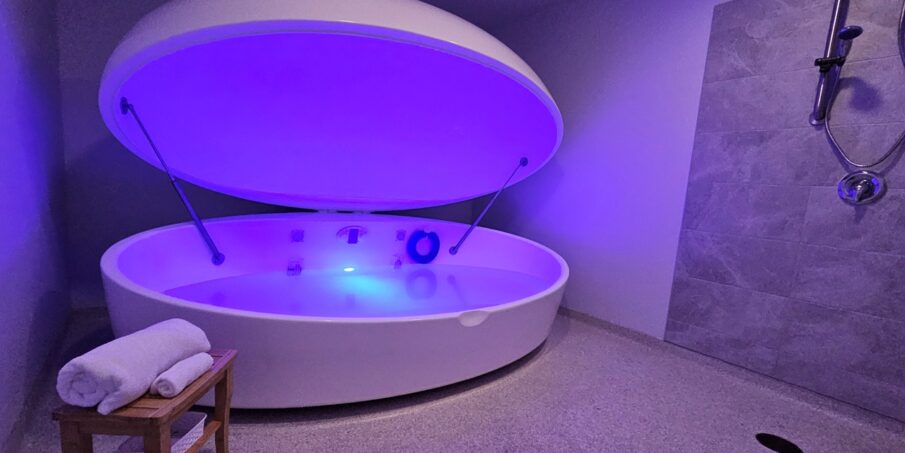Float Session Therapy has been gaining popularity worldwide as a powerful tool for relaxation, mental wellness, and physical recovery. But before diving into the benefits of float therapy, it’s crucial to understand the safety precautions you should know before starting a float session therapy. This ensures that your experience is not only beneficial but also safe and comfortable.
In this blog, we will explore the essential safety tips and precautions while highlighting the many benefits of float therapy, including the health benefits of float therapy, the science behind float therapy, and more.
What Is Float Session Therapy?
Before we discuss safety precautions, let’s understand float therapy. Float session therapy involves floating effortlessly in a sensory deprivation tank filled with saltwater, creating an environment free from external stimuli. This sensory deprivation float therapy allows the body and mind to enter a deeply relaxed state.
The purpose of sensory deprivation tank sessions is to reduce stress, alleviate anxiety, and promote healing. The benefits of float therapy include reduced muscle tension, enhanced mental clarity, and improved sleep quality.
Why Are Safety Precautions Important for Float Session Therapy?
Float therapy session experiences can be incredibly calming and rejuvenating. However, understanding safety precautions is vital to avoid discomfort or adverse effects.
For example, people with certain medical conditions, skin sensitivities, or claustrophobia might need to take special care. Knowing what to expect and how to prepare helps maximize the float session benefits safely.
Top Safety Precautions to Know Before Starting Float Session Therapy
1. Consult Your Doctor If You Have Health Concerns
Although the health benefits of float therapy are numerous, it’s important to consult a healthcare professional if you have:
- Skin conditions (eczema, psoriasis)
- Open wounds or infections
- Epilepsy or seizures
- Severe heart conditions
- Pregnancy
- Claustrophobia or anxiety disorders
Discussing your health history will help you understand whether float therapy is suitable or if special measures are needed.
2. Understand the Purpose of Sensory Deprivation Tank and Its Effects
Knowing the purpose of sensory deprivation tanks helps prepare mentally. These tanks isolate you from external noise, light, and touch to provide deep relaxation. The effects of float therapy may include a feeling of weightlessness, reduced sensory input, and altered perception of time.
If you have anxiety or panic attacks (including float tank anxiety), discuss this beforehand with the float center staff.
3. Avoid Caffeine, Alcohol, and Heavy Meals Before Your Float Therapy Session
To optimize float session therapy benefits, avoid caffeine and alcohol before your session. Both can stimulate your nervous system or dehydrate you, reducing relaxation.
Also, avoid heavy meals at least 1-2 hours prior to your float. A light snack is fine.
4. Shower Before and After Your Float Session
Maintaining hygiene is important for your safety and the cleanliness of the float tank. Most centers require showering before entering the tank to remove oils, lotions, and dirt. Showering after helps rinse off salt residue from your skin.
5. Be Aware of Salt Water in Your Eyes and Ears
The tank contains Epsom salt (magnesium sulfate), which is safe but can cause irritation if it gets into your eyes or ears. Use earplugs if recommended to avoid float tank anxiety related to water in ears.
If saltwater irritates your eyes, rinse them gently with fresh water after the session.
6. Stay Hydrated But Avoid Drinking Too Much Water Just Before Floating
Hydration supports your overall well-being and enhances the benefits of float therapy. However, drinking excessive water right before your session can be uncomfortable while floating.
7. Do Not Float if You Have Open Wounds or Infectious Conditions
Floating with open cuts or contagious skin conditions can increase the risk of infection for you and others. Wait until wounds heal before trying isolation tank therapy.
8. Communicate with the Float Center Staff
Make sure you know how to safely exit the tank and communicate with staff if you feel uncomfortable or need assistance during your float therapy session.
9. Know What to Expect: Duration and Sensations
Typical float therapy sessions last between 60 to 90 minutes. You may experience initial discomfort or anxiety, but most people report profound relaxation.
Understanding this helps reduce float tank anxiety and maximizes the float therapy for relaxation experience.
10. Avoid Float Therapy Immediately After Intense Physical Activity
Although float therapy sessions can aid muscle recovery, it’s best to wait until your body cools down from intense exercise to avoid dizziness or nausea.
What Are the Benefits of Float Therapy?
Float session therapy provides numerous float session benefits, including:
- Stress relief
- Reduced anxiety and depression symptoms (float therapy for depression)
- Muscle relaxation and pain relief
- Enhanced creativity and focus
- Better sleep quality
These benefits of float therapy have made it a popular choice for mental wellness and physical recovery.
The Science Behind Float Therapy
Scientific studies on float tank therapy benefits show that floating can reduce cortisol levels (stress hormone) and increase endorphins. The isolation from sensory inputs reduces brain activity in areas linked to stress, leading to calmness.
Frequently Asked Questions (FAQs)
Q1: Is Float Therapy Safe for Everyone?
While many people benefit, those with certain medical conditions should consult a doctor first.
Q2: How Often Should I Do Float Session Therapy?
Most people experience benefits with weekly or biweekly sessions, but frequency depends on your goals.
Q3: Can I Float If I’m Claustrophobic?
You can try shorter sessions or open tanks. Communicating with staff helps.
Q4: What Should I Bring to My Float Therapy Session?
Bring swimwear if required, earplugs, and a towel if not provided by the center.
Q5: Will I Feel Anxious Inside the Float Tank?
Some people do initially, but most find it deeply relaxing after a few minutes.
Conclusion
Float session therapy offers incredible float deprivation tank benefits that improve mental and physical health. However, understanding what safety precautions you should know before starting float session therapy ensures a positive and safe experience.
By consulting your doctor, preparing properly, and communicating with your float center, you can maximize the benefits of sensory deprivation float tanks and enjoy the transformative power of isolation tank therapy.





